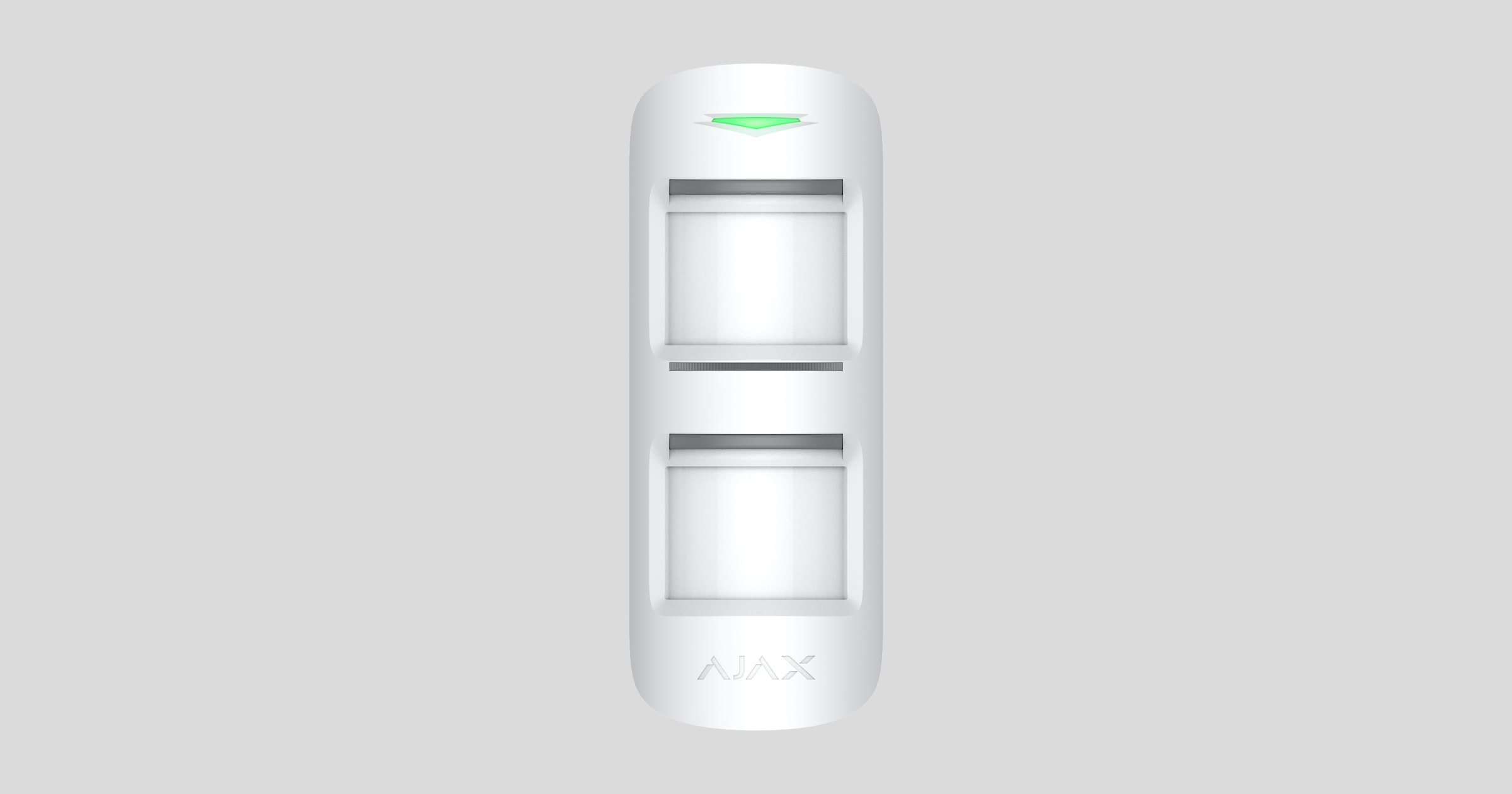MotionProtect Outdoor Jeweller é um detetor de movimento exterior sem fios. A sua distância de deteção de movimento ajustável é de até 15 metros. Dispõe de um sistema anti-mascaramento que ddeteta tentativas de bloquear a visão do detetor. Quando instalado e configurado corretamente, o detetor não reage a animais até 80 cm de altura.
O detetor é compatível com todos os hubs Ajax e repetidores de sinal de rádio. Não está prevista a ligação aos módulos de integração ocBridge Plus e uartBridge.
O MotionProtect Outdoor funciona como parte do sistema Ajax, ligando-se ao hub através do protocolo de rádio seguro Jeweller, concebido para transmitir alarmes e eventos. O alcance de comunicação do hub é de até 1700 metros.
Elementos funcionais
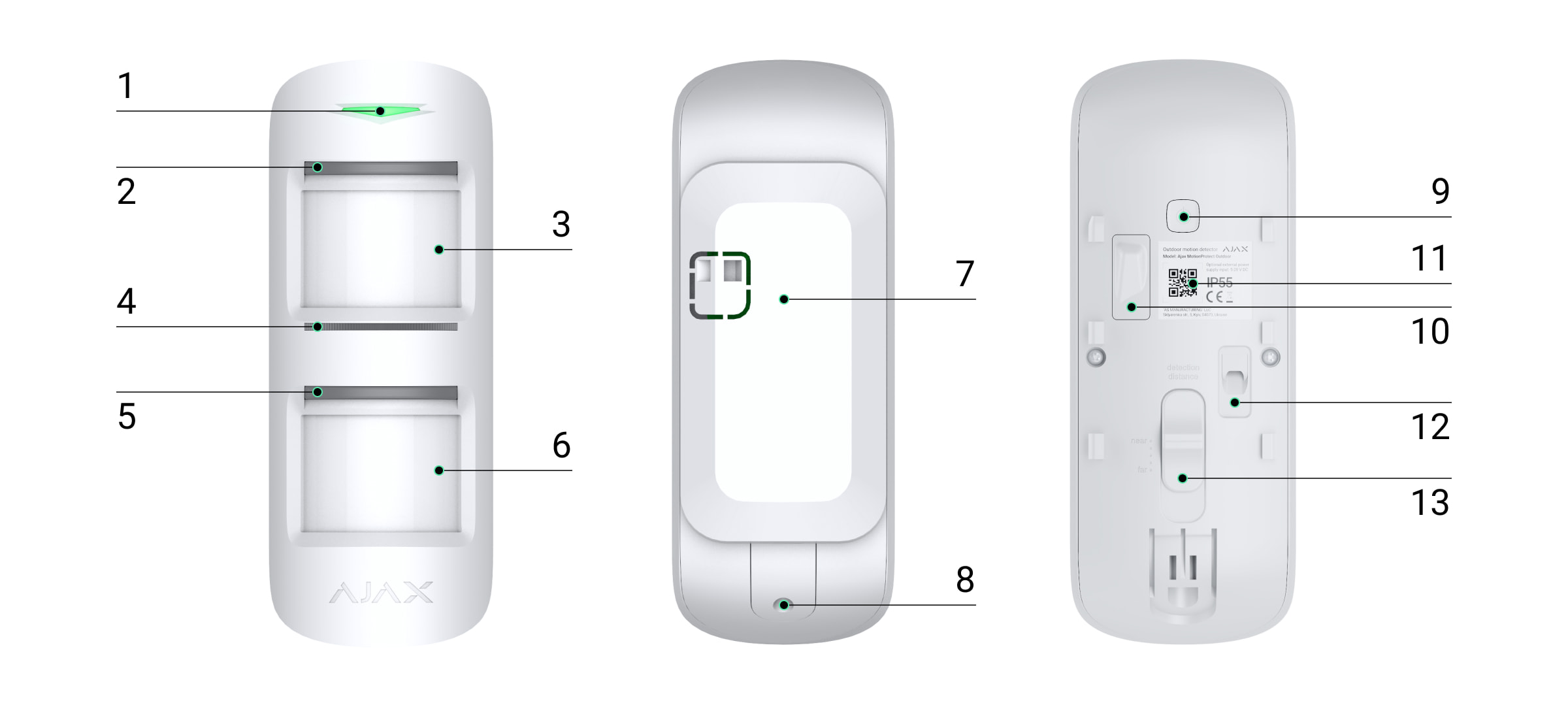
- Indicador LED principal.
- Indicador LED e sensor de mascaramento da lente superior do detetor.
- Lente superior do detetor.
- Sensores de mascaramento.
- Indicador LED e sensor de mascaramento da lente inferior do detetor.
- Lente inferior do detetor.
- Painel de instalação SmartBracket. Para retirar o painel, faça-o deslizar para baixo. A parte perfurada do painel de montagem é necessária para acionar um tamper em caso de tentativa de desprender o detetor da superfície. Não o parta.
- Orifício para fixar o painel de instalação SmartBracket com o parafuso incluído.
- Botão de alimentação do detetor.
- Botão de tamper. Alertas de tentativas de retirar o detetor da superfície ou de o retirar do painel de instalação.
- Código QR do detetor com um identificador. É utilizado para emparelhar o dispositivo com um sistema Ajax.
- Conector para saída do cabo de alimentação externa.
- Barra de deslocação para ajustar a distância de deteção de movimento.
Princípio do funcionamento
MotionProtect Outdoor Jeweller deteta movimentos utilizando dois sensores de infravermelhos (IV) incorporados, captando objetos em movimento com temperaturas próximas das do corpo humano.
Assim que um detetor armado identifica um movimento, envia instantaneamente um alarme para o hub. O hub, por sua vez, ativa as sirenes conectadas, ativa cenários, e notifica a empresa de segurança e os utilizadores.
Os utilizadores sabem exatamente onde o movimento é detetado. As notificações contêm o nome do hub (o nome da instalação protegida), o nome do dispositivo e a sala virtual à qual o detetor está atribuído.
Proteção contra falsos alarmes
Tal como detetores de interior Ajax, o MotionProtect Outdoor utiliza o algoritmo SmartDetect para proteção contra falsos alarmes.
Graças a este algoritmo, o detetor analisa o diagrama térmico lido pelo sensor: a intensidade da radiação infravermelha, o tamanho do ponto de calor, a velocidade do movimento, o tempo passado na área de deteção e outros parâmetros.
Normalmente, nesta altura, o detetor está pronto para tomar uma decisão: ignorar ou ativar o alarme. Mas se a situação não for clara, o detetor ativa o algoritmo LISA em duas fases. Funciona da seguinte forma: assim que ambos os sensores IV detetam movimento, o LISA efetua a correlação e a análise espetral dos sinais, distinguindo entre ameaças reais e interferências.
Análise de correlação
Sempre que um movimento é detetado, o algoritmo LISA analisa e compara as formas de onda de dois sinais dos sensores de infravermelhos em tempo real. Caso sejam semelhantes, o detetor ativa o alarme.
Análise espectral
Quando ambos os sensores IV detetam movimento, mas a análise de correlação não revela uma semelhança suficiente das formas de onda, o LISA compara os componentes de frequência dos sinais dos dois sensores.
Imunidade a animais de estimação

Quando o MotionProtect Outdoor está instalado e configurado corretamente, não reage a animais de estimação com uma altura até 80 cm. O peso do animal de estimação não é levado em conta.
Para ignorar eficazmente todas as interferências típicas do exterior, o detetor possui dois sensores de infravermelhos que leem sinais de duas áreas espaciais. O detetor dispara o alarme se ambos os sensores detetarem movimento em simultâneo.
Quando o detetor é instalado a uma altura de 1 m do nível do solo, os animais podem entrar na zona de deteção de apenas um dos sensores do detetor. Por conseguinte, o MotionProtect Outdoor rejeita estes acionamentos como falsos e não emite o alarme.
Compensação da temperatura
A compensação de temperatura é um mecanismo de software que mantém o contraste do diagrama térmico mesmo que a temperatura ambiente seja próxima da temperatura do corpo humano.
Em cada medição de temperatura ambiente, o detetor introduz uma correção de acordo com a tabela de coeficientes armazenada na sua memória e aumenta ou diminui a sensibilidade dos sensores IR. Isto permite que o detetor identifique eficazmente o movimento em toda a gama de temperaturas de funcionamento de -25 °C a +60 °C.
Proteção contra mascaramento
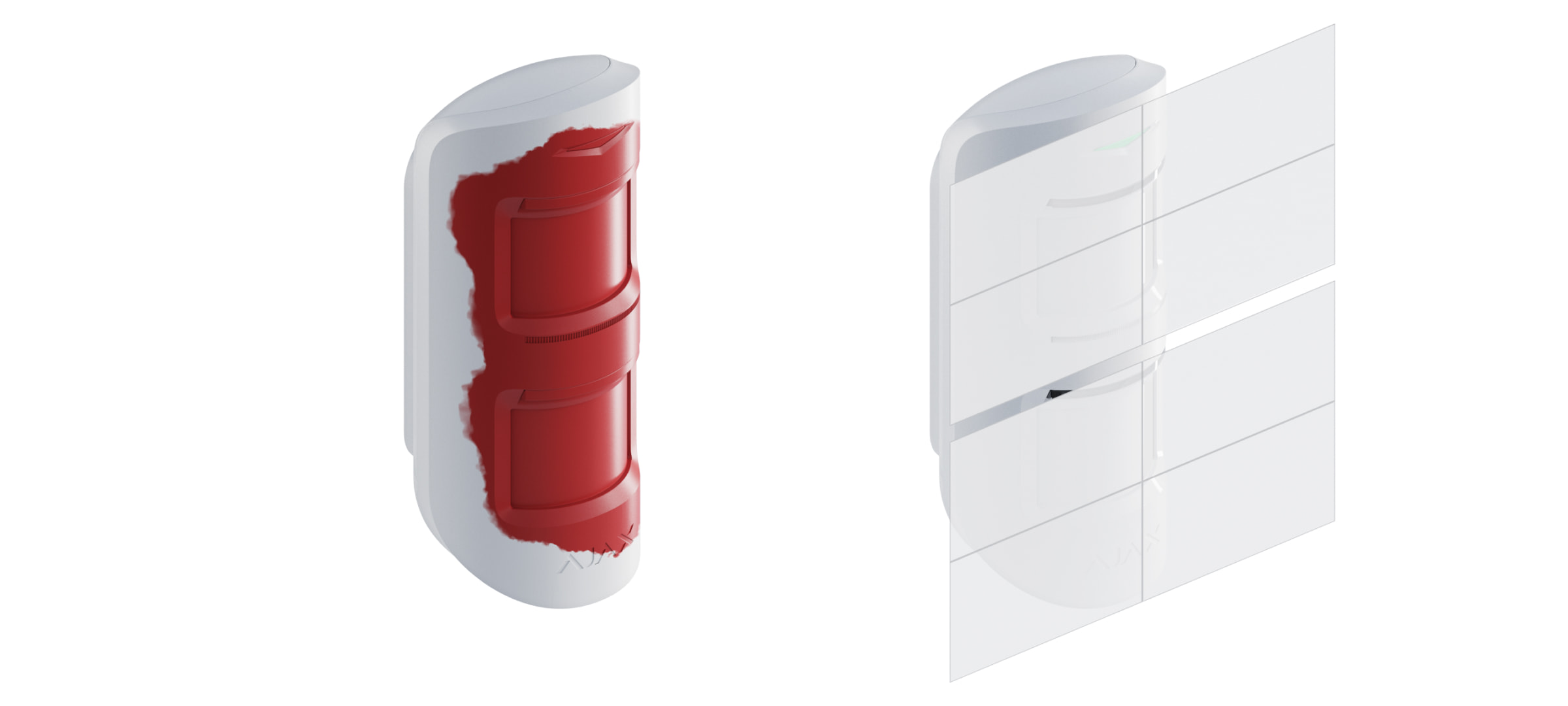
O mascaramento é uma tentativa de bloquear a visão do detetor pintando-o, cobrindo-o, colocando um obstáculo à frente da lente do detetor ou de qualquer outro modo.
O MotionProtect Outdoor deteta os seguintes tipos de mascaramento:
- Obstáculo em frente da lente do detetor a uma distância até 20 cm (a distância máxima depende do tipo de material).
- Obstáculo em frente de qualquer lente a uma distância até 10 cm.
- Pintar sobre qualquer uma das lentes.
- Colagem da parte da frente do detetor com um material opaco.
A anti-mascaramentoestá sempre ativa e funciona independentemente do modo de segurança do detetor ou do sistema.
| Tipo de mascaramento | Detetor está armado | Detetor está desarmado | ||
| Tempo para alarme, s | Tempo para restaurar, s | Tempo para alarme, s | Tempo para restaurar, s | |
| Um obstáculo na frente de ambas as lentes | 2 | 8 | 130 | 10 |
| Um obstáculo à frente de qualquer uma das lentes | 130 | 18 | 130 | 10 |
| Colar ou pintar sobre qualquer uma das lentes | 130 | 18 | 130 | 10 |
| Colagem na parte da frente do detetor | 130 | 18 | 130 | 10 |
| Aplicar tinta ou pincelar a parte da frente do detetor | 130 | 18 | 130 | 10 |
Quando um ou mais tipos de mascaramento são detetados, o detetor ativa um alarme. O LED do detetor acende-se a verde durante 1 s. The system informs the users and the security company about masking. A resposta da sirene ao mascaramento pode ser ativada nos ajustes do detetor para proteção e informação adicionais.
Tecnologia de rádio Jeweller
Jeweller é um protocolo de rádio que proporciona uma comunicação bidirecional rápida e fiável entre o hub e os dispositivos ligados. O protocolo envia instantaneamente notificações de alarme informativas: as empresas de segurança e os utilizadores sabem exatamente qual o dispositivo que disparou, quando, e onde aconteceu.
O Jeweller utiliza a encriptação e a autenticação para se proteger contra sabotagens e também faz regularmente pings nos dispositivos do sistema, apresentando o seu estado em tempo real. Suportando até 2000 m de conetividade sem fios, o Jeweller está preparado para proteger quaisquer objetos e proporcionar a melhor experiência de utilizador, tanto para os proprietários do sistema como para os instaladores.
Transmissão de eventos para a central de monitorização
O sistema Ajax pode transmitir alarmes para a app de monitorização PRO Desktop, bem como para a central recetora de alarmes (CRA), utilizando SurGard (Contact ID), SIA DC-09 (ADM-CID), ADEMCO 685 e outros formatos de protocolos proprietários. A lista de protocolos suportados está disponível aqui.
O MotionProtect Outdoor pode transmitir os seguintes eventos:
- Alarme de movimento.
- Alarme de máscara.
- Alarme de tamper/recuperação.
- Perda/recuperação da ligação entre o MotionProtect Outdoor e o hub (ou repetidor de sinal de rádio).
- Desativação/ativação permanente do MotionProtect Outdoor.
- Tentativa sem êxito de armar o sistema de segurança (com o controlo de integridade do sistema ativado).
Em caso de alarme, o operador da estação de controlo da empresa de segurança sabe o que aconteceu e para onde deve ser enviada a unidade de resposta rápida. Todos os dispositivos Ajax são endereçáveis, pelo que os eventos, o tipo de dispositivo, o nome e a sala atribuída podem ser transmitidos ao PRO Desktop e à CRA. A lista de parâmetros transmissíveis pode diferir dependendo do tipo da CRA e do protocolo de comunicação selecionado com a estação de monitorização.
O ID e o número do dispositivo estão na app Ajax.
Adicionar ao sistema
O hub e o dispositivo que operam em diferentes radiofrequências são incompatíveis. O alcance da frequência de rádio do dispositivo pode variar consoante a região. Recomendamos comprar e utilizar dispositivos Ajax na mesma região. Pode contactar o Suporte Técnico da Ajax para verificar as bandas de frequência de rádio na sua região.
Antes de adicionar dispositivos
- Instale a app Ajax.
- Inicie sessão na sua conta ou crie uma nova conta.
- Selecione um espaço ou crie um novo.
A funcionalidade de espaço está disponível para apps dessas versões ou superiores:
- Ajax Security System 3.0 para iOS.
- Ajax Security System 3.0 para Android.
- Ajax PRO: Tool for Engineers 2.0 para iOS.
- Ajax PRO: Tool for Engineers 2.0 para Android.
- Ajax PRO Desktop 4.0 para macOS.
- Ajax PRO Desktop 4.0 para Windows.
- Adicione pelo menos uma sala virtual.
- Adicione um hub compatível ao espaço. Certifique-se de que o hub está ligado e tem acesso à Internet através de Ethernet, Wi-Fi e/ou rede móvel.
- Certifique-se de que o espaço está desarmado e de que o hub não está a iniciar uma atualização, verificando os estados na app Ajax.
Apenas um PRO ou um administrador com direitos para configurar o sistema pode adicionar um dispositivo ao hub.
Como adicionar o MotionProtect Outdoor
- Abra a app Ajax. Se a sua conta tiver acesso a mais do que um hub ou se estiver a utilizar a aplicação PRO, selecione o hub ao qual pretende adicionar o MotionProtect Outdoor.
- Aceda ao separador Dispositivos
e clique em Adicionar dispositivo.
- Dê um nome ao detetor, digitalize ou insira o código QR (localizado no detetor e na caixa). Selecione uma sala e um grupo para o detetor (se Modo de Grupo estiver ativado).
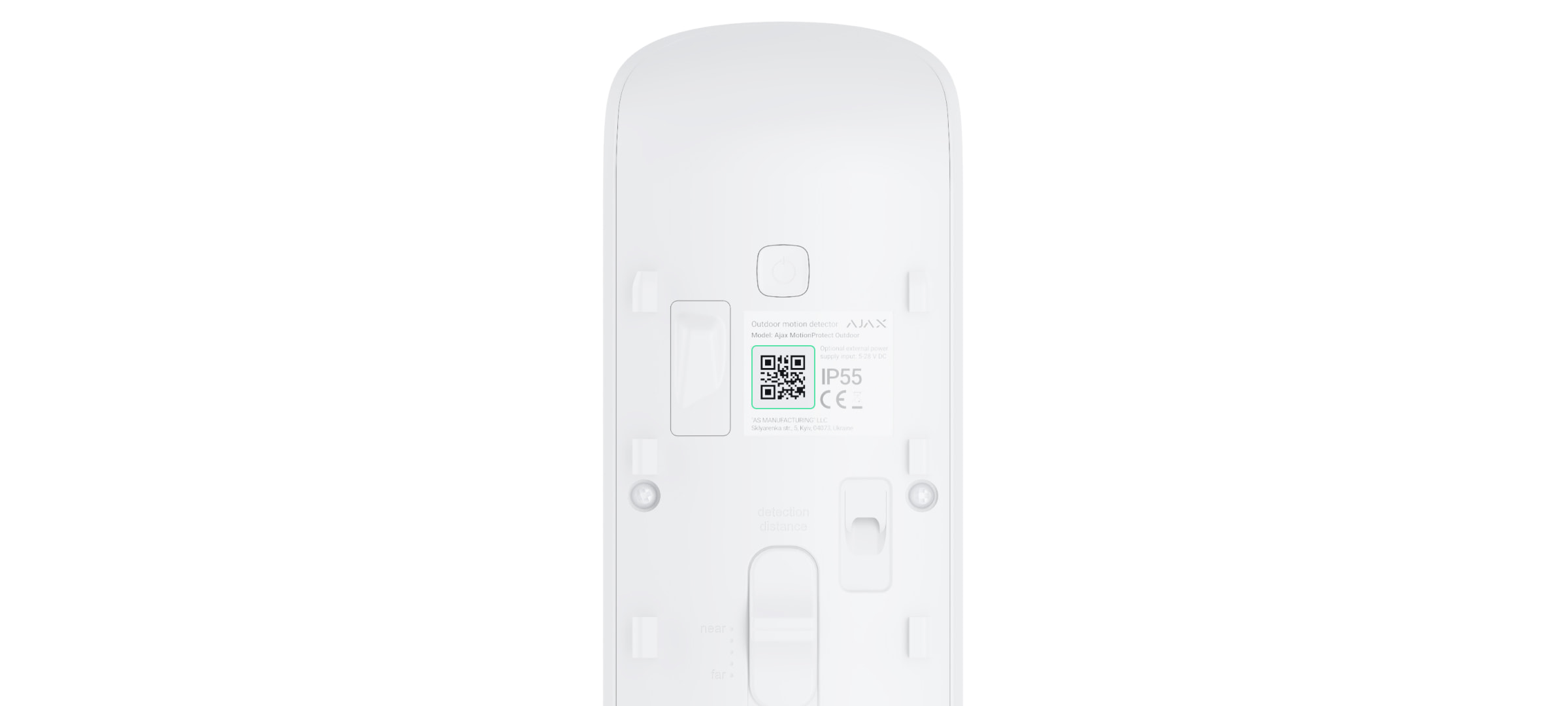
- Prima Adicionar.
- Ative o dispositivo mantendo premido o botão de alimentação durante 3 segundos.

Se a ligação falhar, desligue o detetor e tente novamente dentro de 5 segundos. Se o número máximo de dispositivos já tiver sido adicionado ao hub (dependendo do modelo do hub), receberá uma notificação de erro ao adicionar.
Para garantir que o MotionProtect Outdoor esteja conectado ao hub, o detetor deve estar localizado na mesma instalação que o sistema (dentro do alcance do sinal de rádio do hub). Para funcionar através do repetidor de sinal de rádio, ligue ambos os dispositivos ao hub primeiro e depois ligue o detetor ao repetidor. Pode ser feito nas definições do repetidor.
O detetor ligado aparecerá na lista de dispositivos hub na app Ajax. A atualização dos estados dos dispositivos na lista depende das definições do Jeweller (ou Jeweller/Fibra); o valor predefinido é de 36 segundos.
O MotionProtect Outdoor funciona apenas com um hub. Quando ligado a um novo hub, o detetor deixa de enviar comandos para o antigo. Quando adicionado a um novo hub, o detetor não é removido da lista de dispositivos do hub antigo. Isto deve ser feito manualmente através da app Ajax.
Estados
Os estados apresentam informações sobre o aparelho e os seus parâmetros de funcionamento. Os estados do MotionProtect Outdoor estão disponíveis nas apps Ajax. Para visualizá-los:
- Inicie sessão na app Ajax.
- Selecione o hub se tiver vários ou se estiver a utilizar a app Ajax PRO.
- Aceda ao separador Dispositivos
.
- Selecione o MotionProtect Outdoor na lista.
| Parâmetro | Significado |
| Importação de dados | Apresenta o erro aquando da transferência de dados para o novo hub:
|
| Avaria |
Clicar em O campo só é apresentado se for detetada uma avaria. |
| Temperatura |
Temperatura do detetor. É medido no processador do detetor e muda gradualmente. Erro aceitável entre o valor na app e a temperatura ambiente — 2°C. O valor é atualizado assim que o detetor identifica uma alteração de temperatura de, pelo menos, 2°C. É possível configurar um cenário por temperatura para controlar dispositivos de automatização. |
| Intensidade de Sinal Jeweller |
Intensidade do sinal entre o dispositivo e o hub (ou o repetidor) através do canal Jeweller. O valor recomendado é de 2–3 barras. O Jeweller é um protocolo para a transmissão de eventos e alarmes do MotionProtect Outdoor. |
| Ligação através de Jeweller | Estado da ligação no canal Jeweller entre o detetor e o hub ou o repetidor:
|
| Potência do transmissor |
Apresenta a potência selecionada do transmissor. O parâmetro aparece quando a opção Máx ou Atenuação é selecionada no menu Teste de atenuação do sinal. |
| Carga da bateria | O nível de carga da bateria do dispositivo:
Quando as baterias estão fracas, as apps Ajax e a empresa de segurança recebem as notificações adequadas. Depois de enviar uma notificação de bateria fraca, o detetor pode funcionar até 2 meses. |
| Tampa | O estado do tamper do detetor que responde à separação ou abertura da carcaça do dispositivo:
|
| Alimentação externa | Estado da alimentação externa:
|
| Sensibilidade | Nível de sensibilidade do detetor de movimentos:
A sensibilidade é selecionada com base nos resultados do teste da zona de deteção. |
| Antimascaramento | Estado de mascaramento do detetor:
|
| Sempre Ativo |
Quando esta opção está ativada, o detetor está sempre armado. Neste modo, o detetor responde ao movimento e emite alarmes independentemente do modo de segurança do sistema. |
| Desativação permanente | Mostra o estado da função de desativação permanente do dispositivo:
|
| Reações a Alarmes | |
| Modo de Funcionamento | Mostra como o detetor reage aos alarmes:
|
| Atraso ao Entrar, seg. |
Tempo de atraso na entrada: de 5 a 120 segundos. O atraso de entrada (atraso de ativação do alarme) é o tempo que o utilizador tem para desarmar o sistema de segurança depois de entrar na área protegida. |
| Atraso ao Sair, seg. |
Tempo de atraso na saída: de 5 a 120 segundos. O atraso ao sair (atraso de armar) é o tempo que o utilizador tem para sair das instalações após o armar do sistema de segurança. |
| Atraso ao Entrar no Modo Noturno, seg. |
Tempo de atraso ao entrar no Modo Noturno: 5 a 120 segundos. O atraso de entrada (atraso de ativação do alarme) é o tempo que o utilizador tem para desarmar o sistema de segurança depois de entrar na área protegida. |
| Atraso ao Sair no Modo Noturno, seg. |
Atraso à saída no Modo noturno: de 5 a 120 segundos. O atraso ao sair (atraso de armar) é o tempo que o utilizador tem para sair das instalações após o armar do sistema de segurança. |
| Firmware | Versão do firmware do dispositivo. |
| ID do dispositivo |
ID do detetor. Utilizado para ligar o detetor ao hub. Também disponível no código QR na carcaça do dispositivo e na sua caixa de embalagem. |
| Número do Dispositivo | Número do bucle (zona) do dispositivo. |
Definições
O alcance da deteção de movimento é definido utilizando o interrutor na caixa do detetor (sob o painel de montagem do SmartBracket).
Para alterar as definições do detetor na app Ajax:
- Selecione o hub se tiver vários ou se estiver a utilizar a app Ajax PRO.
- Aceda ao separador Dispositivos
.
- Selecione o MotionProtect Outdoor na lista.
- Aceda a Definições clicando no ícone de engrenagem
.
- Defina os parâmetros necessários.
- Clique Voltar para guardar as definições.
| Definições | Valor |
| Nome |
Nome do detetor. Apresentado na lista de dispositivos hub, texto SMS e notificações no feed de eventos nas apps Ajax. Para alterar o nome do detetor, clique no campo de texto. O nome pode conter até 12 caracteres cirílicos ou até 24 caracteres latinos. |
| Sala |
Seleção da sala virtual à qual o MotionProtect Outdoor está atribuído. O nome da sala é apresentado no texto de SMS e notificações no feed de eventos das apps Ajax. |
| Indicação LED de alarme | When the option is disabled, the LED indicator of the detector doesn’t notify about alarms or tamper triggering. |
| Sensibilidade | Nível de sensibilidade do detetor de movimentos. A escolha depende do tipo de objeto, da presença de fontes prováveis de falsos alarmes e das especificidades da área protegida:
Antes de escolher um nível de sensibilidade, faça o Teste da zona de deteção. Se, durante o teste, o detetor não reagir ao movimento, de 5 em 5 casos a sensibilidade deve ser aumentada. |
| Antimascaramento |
Quando esta opção está ativada, o MotionProtect Outdoor deteta o mascaramento. O MotionProtect Outdoor deteta os seguintes tipos de mascaramento:
|
| Sempre Ativo |
Quando esta opção está ativada, o detetor está sempre armado. Neste modo, o detetor responde ao movimento e emite alarmes independentemente do modo de segurança do sistema. |
| Alerta com uma sirene em caso de deteção de movimento | Quando esta opção está ativada, as sirenes que são adicionadas ao sistema são ativadas quando movimento é detetado pelo MotionProtect Outdoor. |
| Alerta com uma sirene se for detetada uma mascaramento |
Quando esta opção está ativada, as sirenes que são adicionadas ao sistema são ativadas quando o mascaramento MotionProtect Outdoor é detetado. O campo é apresentado e está ativo se a opção Anti-mascaramento estiver ativada. |
| Reações a Alarmes | |
| Modo de Funcionamento | Especifique como este dispositivo irá reagir aos alarmes:
|
| Atraso ao Entrar, seg. |
Tempo de atraso na entrada: de 5 a 120 segundos. O atraso de entrada (atraso de ativação do alarme) é o tempo que o utilizador tem para desarmar o sistema de segurança depois de entrar na área protegida. |
| Atraso ao Sair, seg. |
Tempo de atraso na saída: de 5 a 120 segundos. O atraso ao sair (atraso de armar) é o tempo que o utilizador tem para sair das instalações após o armar do sistema de segurança. |
| Armar no Modo Noturno |
Se a opção estiver ativa, o dispositivo ligado ao módulo de integração passa para o modo armado quando o sistema está definido para o Modo Noturno. |
| Atraso ao Entrar no Modo Noturno, seg. |
Tempo de atraso ao entrar no Modo Noturno: 5 a 120 segundos. O atraso de entrada (atraso de ativação do alarme) é o tempo que o utilizador tem para desarmar o sistema de segurança depois de entrar na área protegida. |
| Atraso ao Sair no Modo Noturno, seg. |
Atraso à saída no Modo noturno: de 5 a 120 segundos. O atraso ao sair (atraso de armar) é o tempo que o utilizador tem para sair das instalações após o armar do sistema de segurança. |
| Teste de Intensidade de Sinal Jeweller |
Passa o dispositivo para o modo de teste de intensidade do sinal do Jeweller. O teste permite-lhe verificar a intensidade do sinal entre o detetor e o hub ou o repetidor através do protocolo de transferência de dados sem fios Jeweller para determinar o local de instalação ideal para o dispositivo. O valor recomendado é de 2–3 barras. |
| Teste da Zona de Deteção |
Passa o detetor para o modo de teste da zona de deteção. O teste permite aos utilizadores verificar como o detetor reage ao movimento e determinar o local de instalação ideal. Se, durante o teste, o detetor não reagir ao movimento de 5 em 5 casos, deve aumentar a sensibilidade ou mudar a localização do detetor. |
| Teste de Atenuação do Sinal |
Passa o dispositivo para o modo de teste de atenuação do sinal. Durante o teste, a potência do transmissor é diminuída ou aumentada para simular uma alteração no ambiente para testar a estabilidade da comunicação entre o detetor e o hub ou repetidor. |
| Manual do utilizador | Abre o Manual do Utilizador do MotionProtect Outdoor na app Ajax. |
| Desativação permanente | Permite ao utilizador desativar o dispositivo sem o retirar do sistema. Estão disponíveis três opções:
O sistema também pode desativar automaticamente dispositivos quando o número definido de alarmes é excedido. |
| Desemparelhar Dispositivo | Desemparelha o dispositivo, desliga-o do hub e elimina as suas definições. |
Indicação
O indicador LED do MotionProtect Outdoor LED pode acender-se a vermelho ou verde, consoante o estado. A indicação pode ser desativada nas configurações do detetor.
Indicação ao premir o botão de alimentação
| Indicação | Evento |
| Lights up red while the power button is pressed. | Pressing the button when the detector is on. |
| Ilumina-se a verde. | Ligação do detetor. |
| First lights up red, then flashes three times and goes off. | Desligar o detetor. |
Indicação de detetor ativado
| Indicação | Evento | Nota |
| Acende-se a verde durante 1 segundo. | Motion alarm / tamper triggering. | O detetor regista o movimento uma vez a cada 5 segundos. |
| Acende-se a verde durante alguns segundos. | Conexão do detetor ao hub. | |
| Acende-se a vermelho e pisca após a primeira ativação. | Erro de hardware. | O detetor precisa de ser reparado; contacte o nosso Apoio Técnico. |
| Acende-se a vermelho e pisca alguns minutos depois de ser instalado no suporte. | A calibração não foi bem sucedida; algo estava a bloquear a visão do detetor, ou este foi instalado incorretamente. |
Recalibrate. Para fazer isso, remova o dispositivo do SmartBracket e reinstale-o. Recalibration will start automatically. Certifique-se de que nada obstrua a visão do detetor. |
| Em caso de alarme, acende-se lentamente a verde e apaga-se. | As baterias do detetor têm de ser substituídas. The detector continues operating, detecting motion, and transmitting alarms to the hub. | O procedimento de substituição da bateria é descrito neste artigo. |
| Lights up green and flashes 3 times per second. | As baterias estão completamente descarregadas. The detector no longer detects motion and does not transmit alarms to the hub. | O procedimento de substituição da bateria é descrito neste artigo. |
Selecionar a localização do dispositivo
O MotionProtect Outdoor é adequado para proteger o território do objeto: casas particulares, parques de estacionamento, locais não aquecidos e outros objetos. O detetor pode ser instalado tanto no exterior como no interior.
O detetor é colocado a 0,8-1,3 metros acima do nível do solo. Para um funcionamento eficaz da função de imunidade a animais de estimação, o detetor é instalado a uma altura de 1 metro do nível do solo. A instalação a uma altura diferente pode levar a um funcionamento incorreto do detetor; este reagirá a animais (falsos alarmes) ou não detetará o movimento humano.
O detetor deve ser instalado numa superfície plana e estável. Por exemplo, na parede de uma casa ou numa cerca sólida. Se o detetor for instalado numa superfície instável e instável, isto dará origem a falsos alarmes.
A carcaça do detetor é colocada de modo a que o eixo da lente fique paralelo ao solo e o percurso de entrada previsto do intruso seja perpendicular ao eixo da lente. Se a área não for plana, a altura de instalação é calculada a partir do ponto mais alto da área monitorizada pelo detetor.
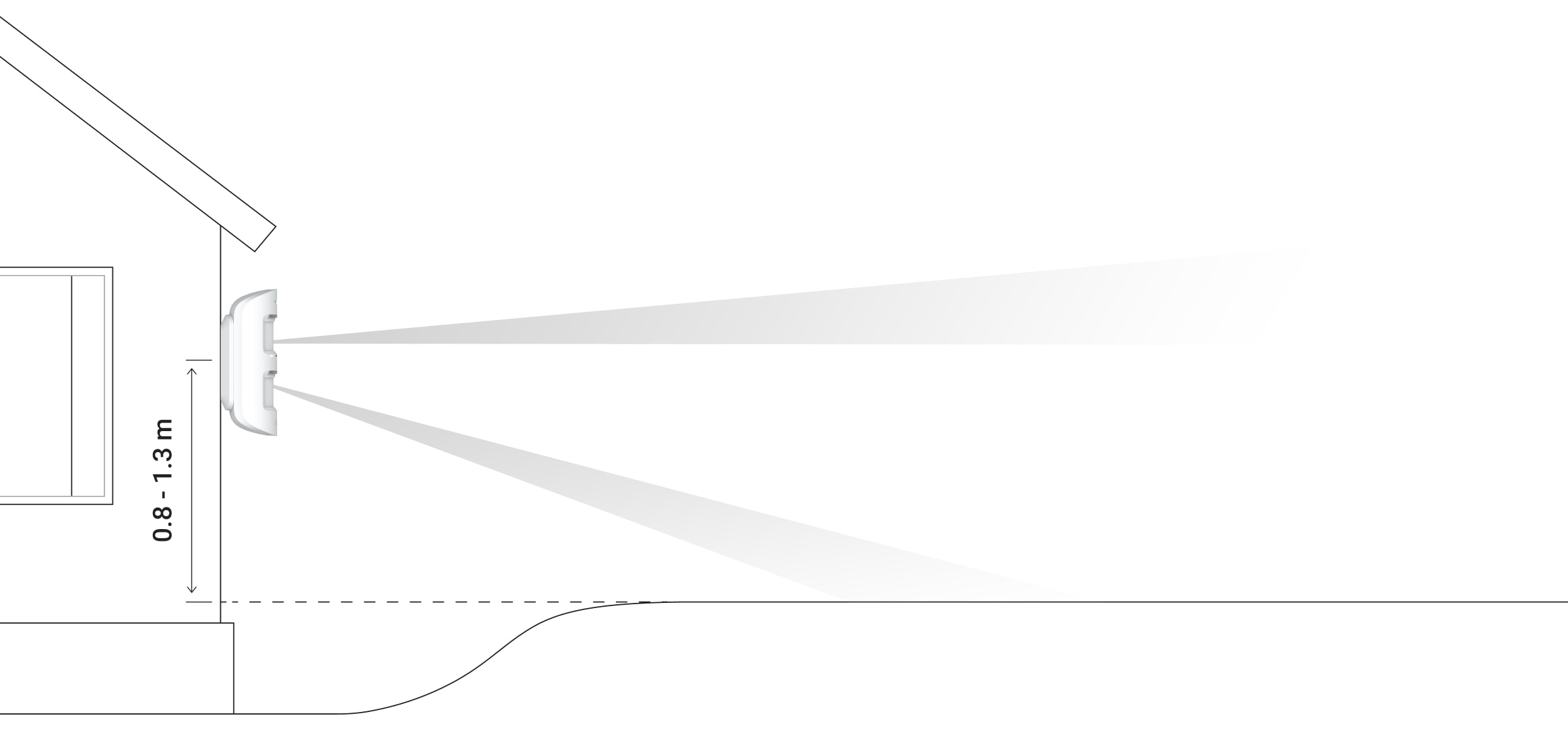
Recomendamos que o detetor seja colocado num canto para que não tenha zonas “cegas” e seja mais difícil de contornar por um intruso. Por exemplo, no canto de uma vedação. Furniture, plants, and ornamental and glass structures should not obstruct the view of the detector or its camera.
If the detector cannot be installed in a corner, it can be mounted on a flat vertical surface: a wall or a fence. Neste caso, instale outro detetor que se sobreponha aos ângulos mortos do primeiro MotionProtect Outdoor.
Ao escolher um local para o dispositivo, considere os parâmetros que afetam o seu funcionamento:
- Área de deteção do detetor de movimentos.
- Intensidade de sinal Jeweller.
- Distância do detetor ao hub ou repetidor.
- Presença de barreiras à passagem de sinais de rádio entre dispositivos: paredes, tetos entre pisos, objetos de grandes dimensões localizados nas instalações.
Considerar as recomendações de colocação ao desenvolver um projeto para o sistema de segurança do objeto. O sistema de segurança deve ser concebido e instalado por especialistas. A lista de parceiros Ajax autorizados está disponível aqui.
Intensidade do sinal
A intensidade do sinal do Jeweller é determinada pelo número de pacotes de dados não entregues ou corrompidos trocados entre o detetor e o hub ou repetidor num determinado período de tempo.
A intensidade do sinal é indicada pelo ícone no separador Dispositivos
. A intensidade do sinal também é indicada nos estados do detetor.
Valor da intensidade do sinal:
- Três barras — excelente intensidade de sinal.
- Duas barras — boa intensidade de sinal.
- Uma barra — fraca intensidade de sinal, não é garantido um funcionamento estável.
- Ícone riscado — sem sinal; o funcionamento estável não é garantido.
Verifique a intensidade do sinal Jeweller no local de instalação. O detetor deve ter uma intensidade de sinal de duas ou três barras.
Se a intensidade do sinal for tão baixa como uma ou zero barras, não podemos garantir o funcionamento estável do sistema de segurança. Reposicione o dispositivo, uma vez que um reposicionamento de 20 cm pode melhorar significativamente a receção do sinal.
Se, após a recolocação, o detetor continuar a ter uma intensidade de sinal baixa ou instável, utilize um repetidor do sinal de rádio.
Zona de deteção
Ao escolher o local onde colocar o detetor, faça o Teste da zona de deteção para determinar o setor em que o detetor reconhece movimentos com a maior precisão possível.
The detection distance is adjusted using the Detection Distance scrollbar on the rear panel of the detector.
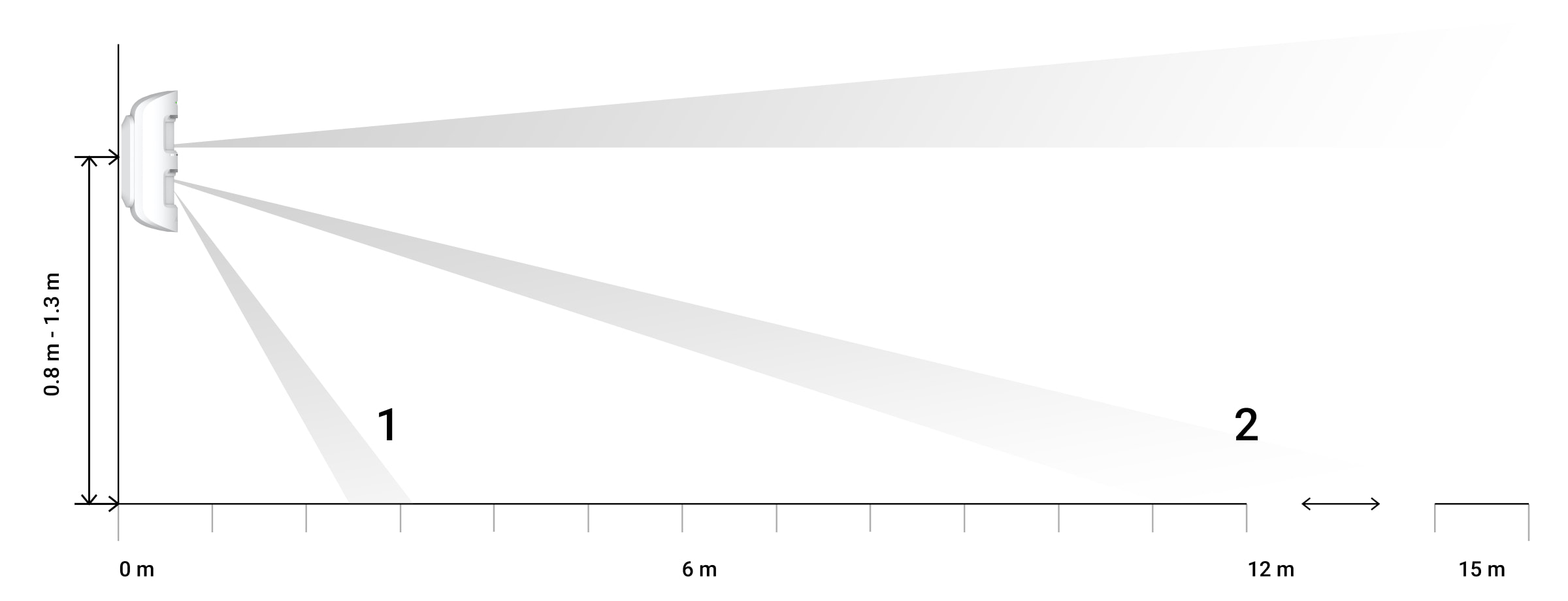
| Scrollbar position | Sensibilidade | Distância de deteção de movimentos |
| Primeira barra (corresponde à inscrição perto da carcaça do detetor) | Baixo Normal Elevada |
Até 3 metros |
| Third bar | Baixo | Até 7 metros |
| Normal Elevada |
Até 8 metros | |
| Quinta barra (corresponde à inscrição far na carcaça do detetor) | Baixo Normal Elevada |
Até 15 metros |
O alcance de deteção quando instalado a uma altura de 0,8-1,3 metros foi testado a um nível médio de sensibilidade com +23°C temperatura ambiente e tempo limpo. Tipo de movimento – andar. Other conditions may produce different results. Por conseguinte, ao instalar o detetor, certifique-se de que faz um Teste da zona de deteção.
Ao selecionar um local de instalação, tenha em consideração o ângulo de visão horizontal do detetor e a largura e dimensão da área de deteção. Incorrect detector placement can lead to false alarms.
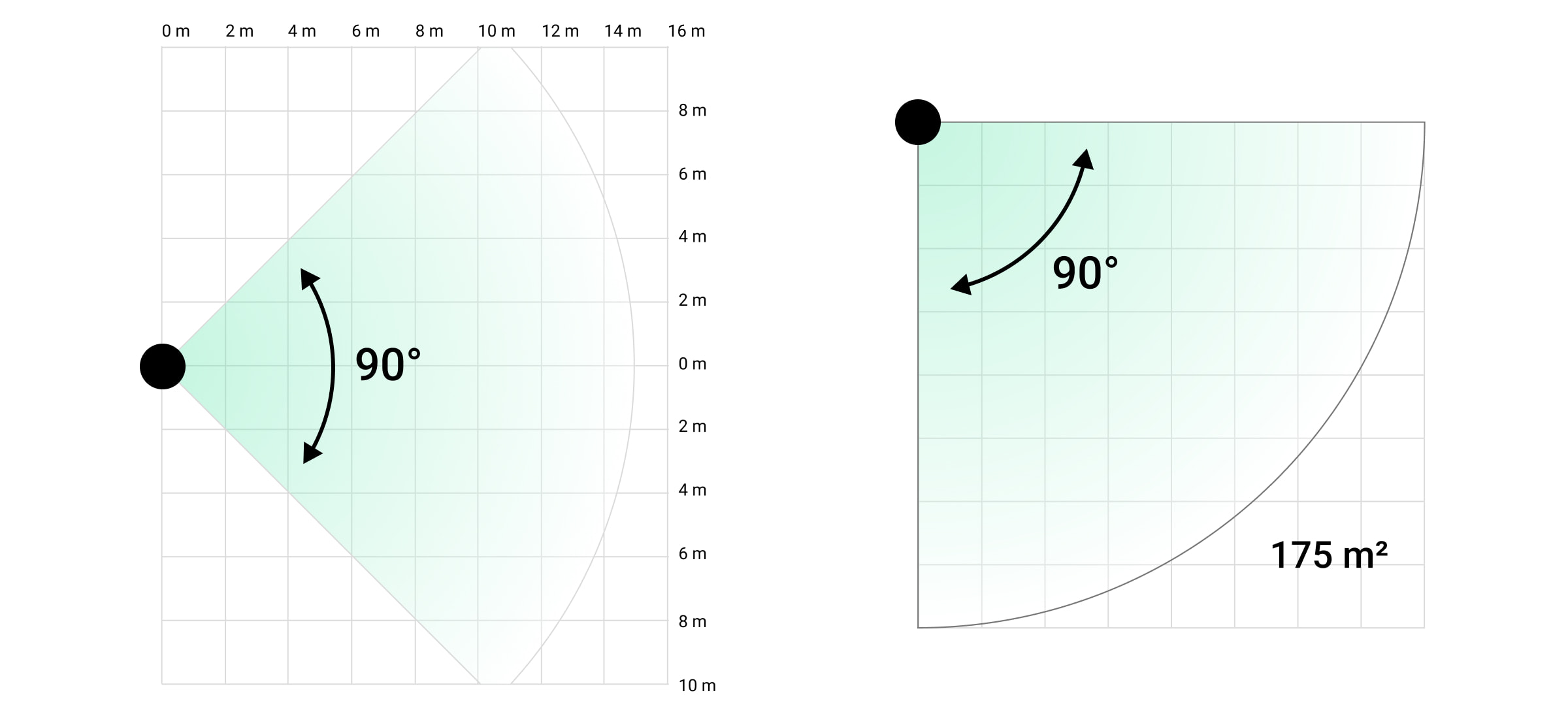 |
|
| O ângulo de visão horizontal do detetor | Área máxima de cobertura do detetor |
Onde não instalar o detetor
- Perto dos objetos metálicos e dos espelhos. Podem blindar e atenuar o sinal de rádio.
- Opposite trees with leaves in the detection zone of both IR sensors of the detector. This can lead to false alarms in warm weather.
- In places where the detection zone of the detector might include bushes 80 cm high or above. This can lead to false alarms in warm weather.
- Em locais onde objetos e estruturas possam bloquear a visão do detetor. Por exemplo, atrás de uma flor ou de uma coluna. Desta forma, a visão do detetor será limitada e será mais difícil detetar o movimento.
- Em locais onde as estruturas de vidro podem obstruir a visão do detetor. O detetor não deteta movimento atrás de vidro.
- Em locais com intensidade do sinal baixa ou instável.
- A menos de 1 metro do hub.
Instalação do detetor
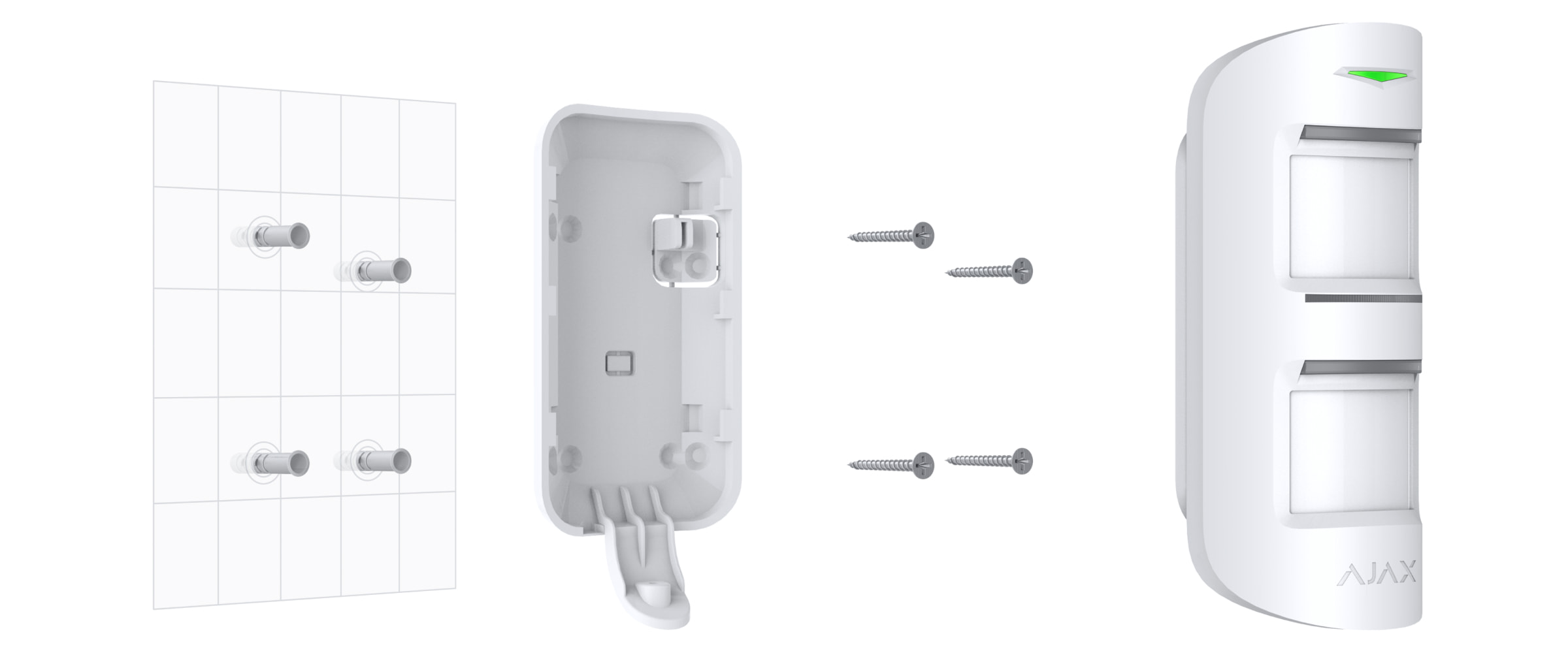
Before installing the detector, make sure that you have selected the optimal location and that it complies with the requirements of this manual. Não se esqueça de definir a distância de deteção necessária (Barra de deslocação de Distância de deteção).
Para instalar o MotionProtect Outdoor:
- Retire o painel de instalação SmartBracket deslizando-o para baixo.

- Conecte a alimentação externa se tenciona utilizá-la.
- Fixe o painel de montagem do SmartBracket com fixadores temporários. A altura de instalação é de 0,8-1,3 m do nível do solo. Para o funcionamento correto da função de imunidade a animais de estimação, o detetor é instalado a uma altura de 1 m do nível do solo.
- Monte o detetor no painel de montagem SmartBracket. Automatic calibration of the masking sensors will start.
- Saia da zona de deteção do detetor e certifique-se de que não existe qualquer movimento no campo de visão do detetor. Isto é necessário para a calibração correta dos sensores de mascaramento. Durante a calibração, a luz do detetor fica verde e pisca uma vez por segundo. A calibração demora até 2 minutos.
- Faça o teste de intensidade do sinal Jeweller. O valor recomendado é de duas ou três barras. Se a intensidade do sinal for tão baixa como uma ou zero barras, não podemos garantir o funcionamento estável do sistema de segurança. Reposicione o dispositivo, uma vez que um reposicionamento de 20 cm pode melhorar significativamente a receção do sinal. Se, após a recolocação, o detetor continuar a ter uma intensidade de sinal baixa ou instável, utilize um repetidor do sinal de rádio.
- Faça o Teste da zona de deteção. Para verificar o detetor de movimentos, aproxime-se do detetor, observando a resposta do indicador LED, e determine a área de deteção.
Test the lower sensor first and then the upper one. Isto ajudará a determinar e a definir a distância máxima de deteção necessária do detetor (determinada pelo sensor inferior).
Em seguida, execute o teste da zona de deteção para ambos os sensores em simultâneo, bem como o teste dos sensores de encobrimento. Se não houver resposta ao movimento, selecione outro nível de sensibilidade utilizando a barra de deslocação da Distância de Deteção e verifique o ângulo de inclinação do detetor.
- Fixe o painel de instalação do SmartBracket com os parafusos fornecidos, utilizando todos os pontos de fixação (um deles encontra-se na parte perfurada do painel de instalação, acima do tamper). Se utilizar outros elementos de fixação, certifique-se de que não danificam ou deformam o painel de instalação.
O painel de montagem permite a montagem do detetor MotionProtect Outdoor numa superfície vertical ou no canto de uma divisão. O SmartBracket tem orifícios especiais que devem ser perfurados para fixar o painel com os parafusos incluídos.

- Deslize o MotionProtect Outdoor para o painel de montagem e aguarde que a calibração seja concluída.
- Prenda a carcaça ao painel de instalação usando o parafuso incluído na parte inferior do detetor. Isto é necessário para uma fixação mais fiável e proteção contra desmontagem rápida.

- Verifique o estado de tamper na app Ajax e teste o detetor.
Ligação de fonte de alimentação externa
Pode ligar uma fonte de alimentação externa de 5-28 V⎓, 200 mA ao detetor. Após conectar a fonte de alimentação externa, não remova as baterias pré-instaladas, pois elas fornecem energia de reserva.
Para ligar a fonte de alimentação externa:
- Retire o painel de instalação SmartBracket puxando-o para baixo.

- Desparafuse os parafusos e remova cuidadosamente a parte traseira da carcaça do detetor.
Não remova a junta de silicone instalada na junção entre as duas partes da carcaça – protege o detetor da entrada de humidade na carcaça.

- Prepare um buraco para a saída do cabo nos pontos indicados no painel de montagem SmartBracket.

1 — Para a saída do cabo de alimentação na parte de trás do painel de montagem do SmartBracket.
2 — Para a saída do cabo de alimentação na parte inferior do painel de montagem SmartBracket. - Encaminhe o cabo de ligação da fonte de alimentação externa através do buraco feito no painel de montagem.
- Encaminhe o cabo através do buraco especial na parte de trás da carcaça do detetor. Não retire o tampão de silicone – este protege o detetor da entrada de humidade no interior da carcaça.

- Encaminhe os fios em condutas especiais e fixá-los com um suporte de feixe – um suporte de plástico com um parafuso.

- Prepare os fios para a conexão. As extremidades dos fios que vão ser inseridos nos terminais devem ser estanhadas ou cravadas com pontas especiais. Isto assegurará uma conexão fiável.
- Conecte os fios aos terminais do detetor seguindo a polaridade.

- Conecte a outra extremidade do cabo à fonte de energia seguindo a polaridade. A fonte de alimentação deve ser desenergizada no momento da conexão.
Utilize apenas uma fonte de alimentação com ligação à terra.
- Fonte de alimentação para o detetor. O estado da ligação pode ser verificado nos Estados do detetor nas apps Ajax, o campo Alimentação externa mudará o seu estado para Ligado.
- Monte a carcaça do detetor e aperte os parafusos. Verifique a junta de silicone antes da montagem: deve encaixar bem na parte de trás da caixa.
Instalação do Hood
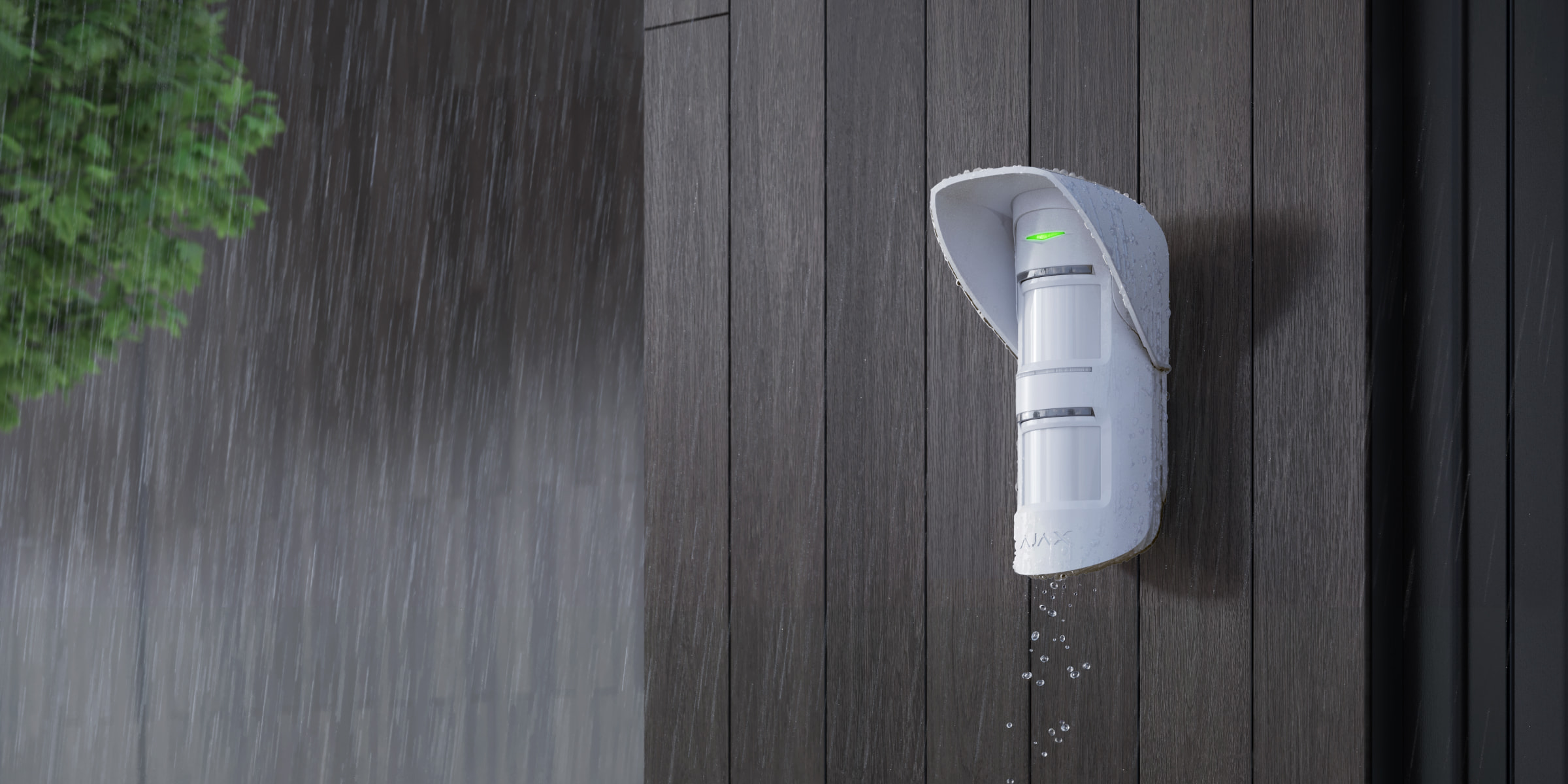
Hood é uma cobertura superior para o MotionProtect Outdoor que protege os sensores de mascaramento da chuva e da neve. É utilizado quando o detetor não pode ser instalado sob um toldo ou uma cobertura.
Hood não está incluído no conjunto do MotionProtect Outdoor.
Hood pode ser montado num detetor já instalado, pelo que não é necessário remover o MotionProtect Outdoor do painel de montagem.
Hood prende-se ao detetor com um fecho Dual Lock™ reutilizável, que permite instalar e remover o Hood em qualquer altura.
Para instalar o Hood:
- Remova a película protetora da fita Dual Lock™ que está colada na superfície interna da viseira.
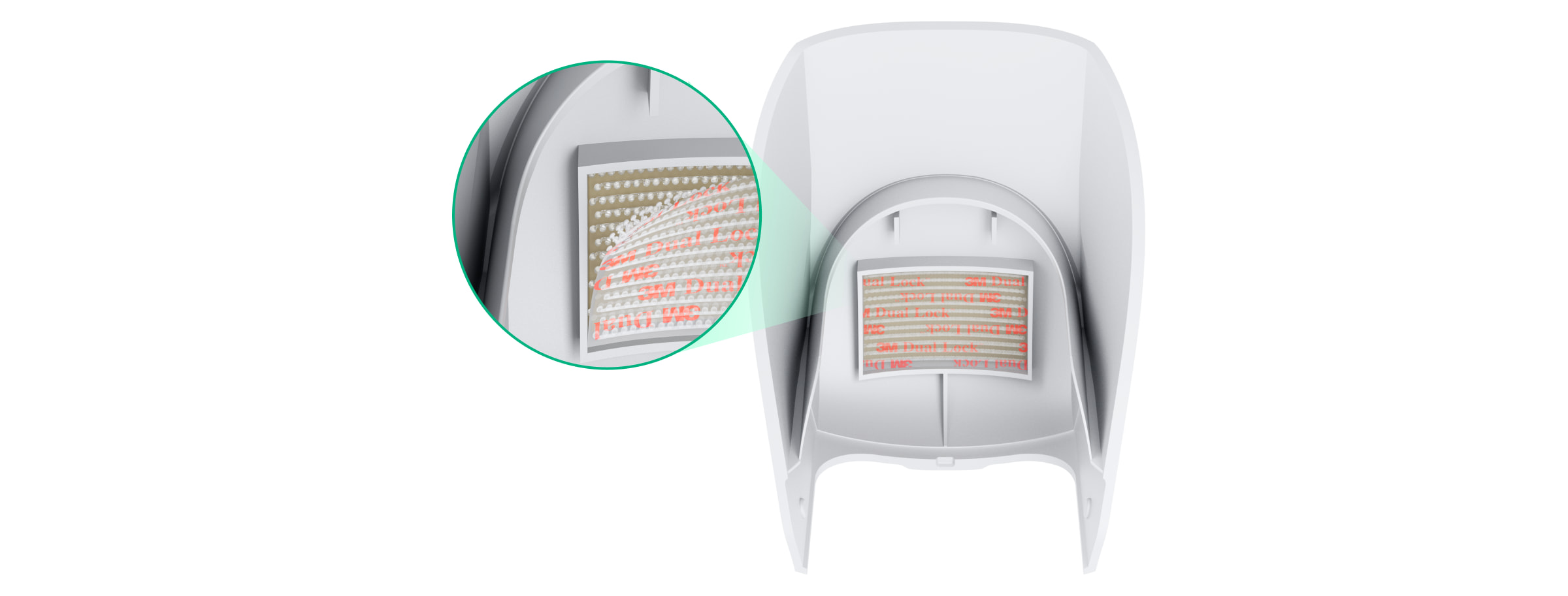
- Coloque a Hood no MotionProtect Outdoor — parte da fita ficará presa à carcaça do detetor.
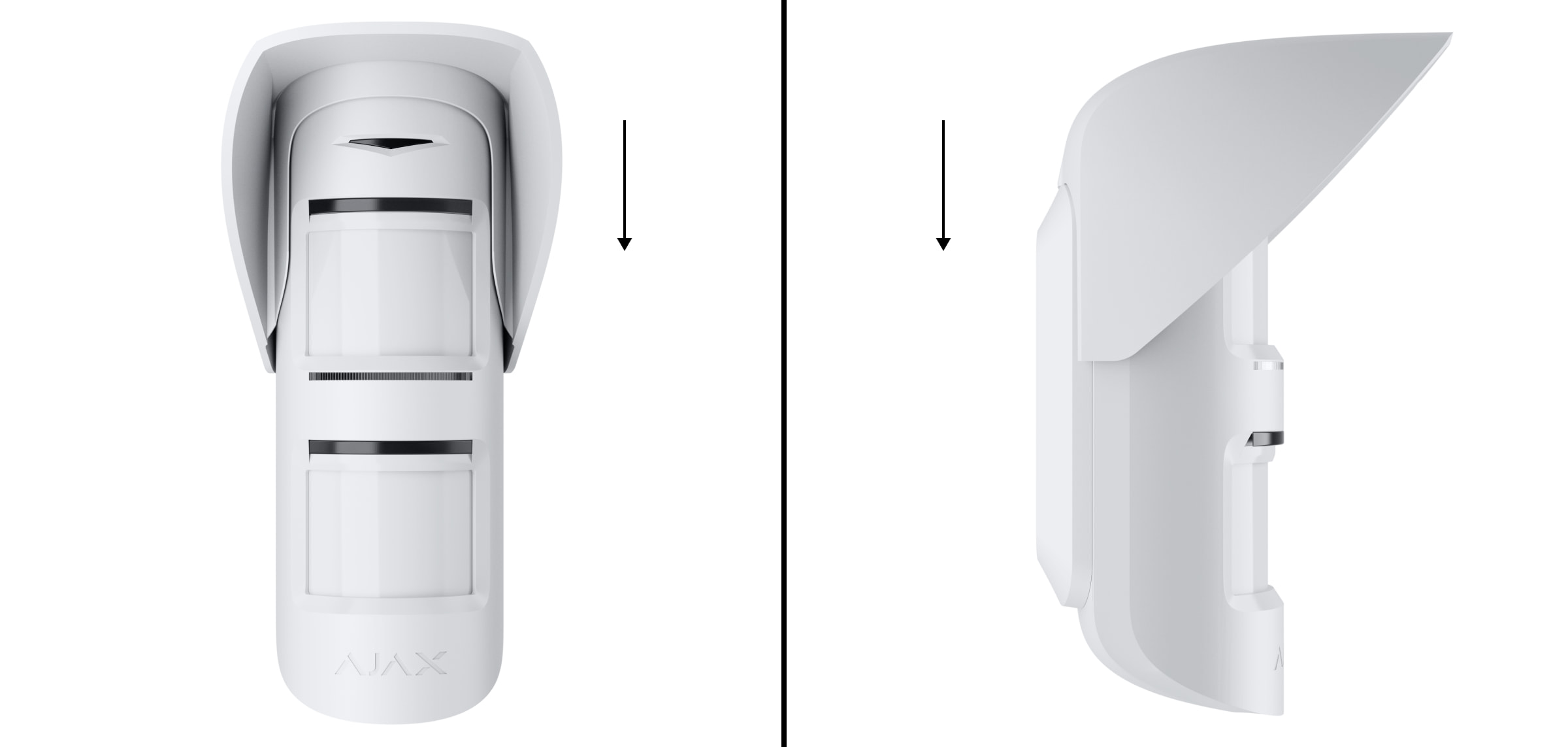
- Retire Hood do MotionProtect Outdoor e alise a parte da fita que ficou colada à carcaça, pressionando-a um pouco para baixo.

- Coloque Hood de volta no detetor. Quando as duas partes da fita estiverem coladas, ouvirá um clique – isto significa que Hood está bem preso.
Teste de funcionalidade
O sistema Ajax propõe vários testes para o ajudar a selecionar corretamente o local de instalação do dispositivo. Os testes não começam imediatamente, mas apenas após um único intervalo de ping do dispositivo hub (especificado nas definições Jeweller ou Jeweller/Fibra).
Testes disponíveis para o MotionProtect Outdoor:
- Teste de intensidade do sinal Jeweller — ajuda a determinar a intensidade e a estabilidade do sinal no local de instalação do dispositivo.
- Teste da zona de deteção — ajuda a determinar a que distância o detetor irá detetar um alarme no local da instalação atual.
- Teste de atenuação — simula uma alteração do ambiente na sala para verificar a estabilidade da ligação entre o dispositivo e o hub, reduzindo ou aumentando artificialmente a potência do transmissor de rádio.
Como efetuar um teste
- Selecione o hub se tiver vários ou se utilizar a app Ajax PRO.
- Aceda ao menu Dispositivos
.
- Selecione o MotionProtect Outdoor.
- Aceda às definições do MotionProtect Outdoor clicando no ícone
.
- Selecione o teste pretendido.
- Faça o teste seguindo as sugestões da app.
Manutenção
Limpe a carcaça do dispositivo do pó, teias de aranha e outros contaminantes à medida que vão surgindo. Utilize um pano seco e macio adequado para a manutenção do equipamento.
Não utilize substâncias que contenham álcool, acetona, gasolina e outros solventes ativos para limpar o dispositivo. Limpe cuidadosamente a lente — os riscos no plástico podem reduzir a sensibilidade do detetor.
O funcionamento autónomo calculado do dispositivo a partir de uma bateria pré-instalada é de até 5 anos (com o intervalo de ping de 3 minutos pelo hub). Se a bateria do detetor estiver fraca, o sistema de segurança envia uma notificação apropriada e o LED acende-se e apaga-se gradualmente se um movimento for detetado ou se o tamper for ativado.
Especificações técnicas
Conjunto completo
- MotionProtect Outdoor Jeweller.
- Painel de instalação SmartBracket.
- Duas baterias CR123A (pré-instaladas).
- Kit de instalação.
- Guia de início rápido.
Garantia
A garantia dos produtos da empresa de responsabilidade limitada “Ajax Systems Manufacturing” é válida durante 2 anos após a compra.
Se o dispositivo não funcionar corretamente, recomendamos que contacte primeiro o serviço de assistência, uma vez que, na maioria dos casos, os problemas técnicos podem ser resolvidos remotamente.
Contactar o Suporte Técnico:
